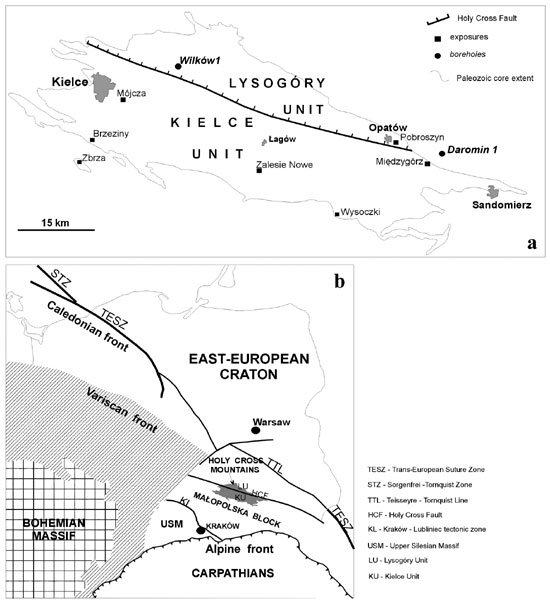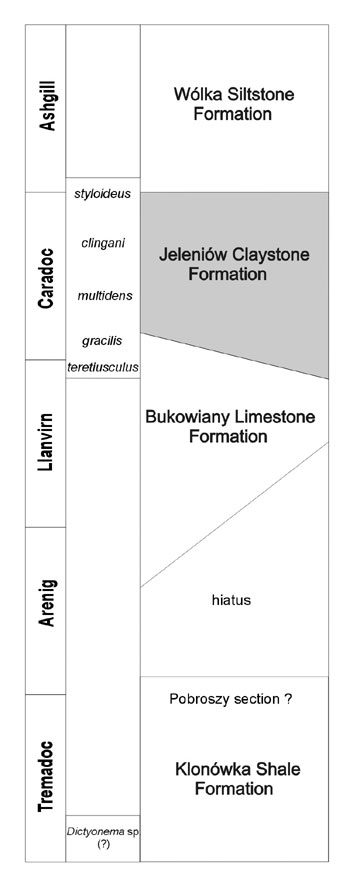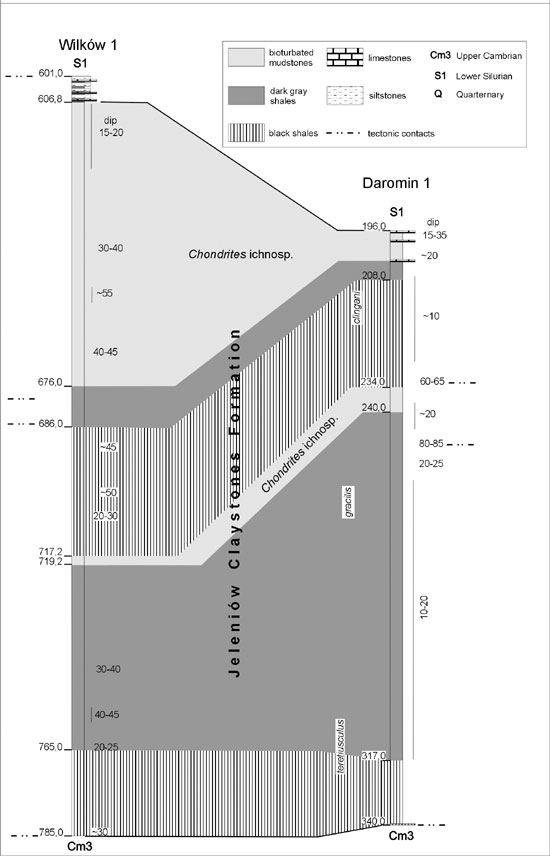
Sedimentological record of Oxygen–depleted conditions in Upper Ordovician of central Poland (Holy Cross Mts.)
Wieslaw Trela1
1 Polish Geological Institute, Holy Cross Branch, Zgoda 21, 25-953 Kielce. E–mail: trela@pgi.kielce.pl
Key words: Chondrites. Bioturbation. Black shales. Oxygen depletion. Ordovician.
Introduction
This report presents the preliminary results concerning a sedimentary environment of the Upper Ordovician (Caradoc) black shales and related bioturbated mudstones in the Lysogóry Unit of the Holy Cross Mts (south-eastern central Poland). The sedimentological investigations described here were based on observations of the Upper Ordovician deposits in Wilków 1 and Daromin 1 boreholes (Figure 1a).
There is no sedimentological and environmental analysis of the Upper Ordovician deposits from the Lysogóry Unit, especially the black shales. Previous works were focused on stratigraphy of the Upper Ordovician, as well as tectonic history and paleogeography of the Lysogóry Unit (Czarnocki, 1950; Kielan, 1959; Tomczyk and Turnau-Morawska, 1967; Tomczykowa, 1968; Deczkowski and Tomczyk, 1969; Bednarczyk, 1981; Tomczykowa and Tomczyk, 2000).
Geological setting
The Paleozoic of the Holy Cross Mts. (HCM) is divided into two facies belts: Kielce (KU) and Lysogóry (LU) units separated by the Holy Cross Fault (Figure 1 a, b). The KU forms northern part of the Malopolska Block (MB) (Figure 3) that is believed to be a separate terrain of Gondwanian provenance (Belka et al., 2000) or proximal terrain detached before Ordovician from Baltica (Dadlez et al., 1994). The paleomagnetic data indicate that the KU was located in the present position at the margin of Baltica as early as the latest Silurian (Nawrocki, 1999). There are two different points of view on geotectonic nature of the LU: it is considered as terrain located between the East European Craton (EEC) and the MB (Pozaryski, 1990) with suggested Gondwanian provenance (Belka et al., 2000; Valverde-Vaquero et al., 2000), or as a part of a passive margin of the EEC (Dadlez et al., 1994).
The Upper Ordovician of the LU is divided into Jeleniów Claystone Formation (JCF) of Caradoc age and Wólka Siltstone Formation (WSF) representing the Ashgill (Figure 2) (Bednarczyk, 1981). The JCF is developed as claystone and mudstone shales that reach over 100,0 m in thickness whereas 50,0 m thick WSF is represented by mudstones and siltstones intercalated with thin limestones and claystone interbeds (Czarnocki, 1950; Kielan, 1959; Tomczyk and Tumau-Morawska, 1967; Tomczykowa, 1968; Deczkowski and Tomczyk, 1969). Within the JCF graptolites of teretiusculus/gracilis, multidens and clingani zones were distinguished (Tomczyk and Turnau-Morawska, 1967; Deczkowski and Tomczyk, 1969). The JCF is underlain by carbonates of the Bukowiany Limestone Formation (BF) (uppermost Llanvirn – lowermost Caradoc) (Bednarczyk, 1981). However the biostratigraphy and facies extent in the eastern part of the LU suggest that the upper part of BF is coeval with the lower part of JCF (cf., Tomczykowa and Tomczyk, 2000; Trela et al., 2001; Wrona, 2002).

Figure 1. A. Locations of the investigated boreholes (Wilków 1 and Daromin 1) in the Lysogóry Unit; B. Location of the Holy Cross Mts. and the Lysogóry Unit on background of the main geotectonic units of Poland (according to Dadlez et al., 1994).
Facies
Two facies types can be recognized within the JCF (Figure 3):
Black and dark gray shales. Unbioturbated, finely laminated black, partially carbonaceous with thin chert laminae. Thin microlaminae composed of skeletal detritus can be visible under the microscope. The black shales pass gradually to dark gray shaly claystones. Abundant pyrite framboids occur within the black sediment. This facies is normally free of any macrobenthos apart from dispersed minute size Paterula sp. brachiopods of in the dark gray shales (Tomczykowa and Tomczyk, 2000). Angular silt-size quartz grains, mostly disseminated, and sporadic phosphorite clasts appear as well.
Bioturbated mudstones. They are gray to green mudstones with abundant but not diverse trace fossils dominated by fodinichnial Chondrites that occur throughout most of the facies and less common Planolites. Furthermore the linear, indeterminate crawling traces occur within the analyzed facies; some of them cross-cutting each other. On the bedding planes they show backfilled structures and preserved spreiten structure in the longitudinal and traverse sections, resembling Teichichnus pattern. They appear in a less frequency than Chondrites. There are also rare, carbonate mudstone interbeds, up to 15 cm thick. In contrary to black shales, apart from framboids the large euhedral pyrite cubes occur within the bioturbated mudstones.
Spatial and temporal changes of sedimentary environment
Two black and dark gray shale horizon, each of them followed by bioturbated mudstones, were recognized within the JCF (Figure 3). In the transitional zone between black shales and bioturbated mudstones, the gray-green mudstones are intercalated by thin black laminae. The lower black shales are coeval with the boundary of the teretiusculus and gracilis zones, and the upper one with the boundary of the multidens and clingani zones.
Preservation of the delicate lamination in the black shales and the lack of the bioturbation and macrobenthos supports its deposition in an environment that was hostile to life, with oxygen-poor bottom waters (cf., Savrda and Bottjer, 1986; Tyson and Pearson, 1991; Tyson, 1995). The bedding planes are barren of surface grazing trails, therefore the base of the water column of the sedimentary basin also may have been oxygen-depleted, preventing the colonization and burrowing activity of the epibenthic organisms. The original millimeter-scale fine lamination indicates deposition in a low energy environment, away from the continuous currents. However presence of the microlaminae composed of skeletal detritus indicate that the sedimentary environment was affected by weak distal storm events.
The occurrence of bioturbated mudstones above the lower and upper black shales may be associated with slightly higher oxygenation in the sediment. The lower bioturbated horizon seems to represent a short-lived event that interrupted the long lasting oxygen depletion of the sedimentary environment. Within the bioturbated mudstones, dysaerobic conditions prevailed, allowing colonization of the sediment by high density and very low diversity deposit feeders, dominated by Chondrites (cf., Bromley and Ekdale, 1984; Savrda and Bottjer, 1986; Edkale and Mason, 1988).

Figure 2. Lithostratigraphy of the Ordovician in the Lysogóry Unit.

Figure 3. The Upper Ordovician facies in Wilków 1 and Daromin 1 boreholes.
The black shales in the LU are coeval with occurrence of the same facies in the SW margin of EEC (Modlinski, 1982) what was likely associated with widespread anoxia within the Tornquist Sea during the latest Lanwirn to Late Caradoc. The alternation of the black shales and bioturbated mudstones in the LU may represent fluctuation of the thermocline controlled by relative sea-level changes. The deeper oxygen-depleted waters of the Tornquist Sea might have been a source of nurtients entered by upwellings in the KU during the latest Llanvirn to the early Late Caradoc that affected the sedimentary environment of the Upper Ordovivian carbonate system (Trela, 2000, 2002). The disappearance of the upwellings in the KU is coeval with development of the upper bioturbated mudstone horizon in the LU.
Conclusions
Two horizons of black and dark gray shales, each of them followed by bioturbated mudstones, were recognized in the Jeleniów Claystone Formation in central Poland (Lysogóry Unit of the Holy Cross Mts.). The lower black shales are coeval with the boundary of teretiusculus/gracili zones and the upper with the multidens/clingani zones. These horizons represent sequences with an upward trend of increasing levels of dissolved oxygen in the bottom waters or at the sediment-water interface. The basal part of each sequence was predominantly deposited in an oxygen-depleted environment with spells of dysaerobic conditions favorable to opportunistic colonization of endobenthos. The black shales in the LU are coeval with widespread anoxia within the Tornquist Sea during the latest Lanwirn to Late Caradoc.
Acknowledgements
This work is a contribution to Paleozoic Accretion of Poland (PCZ 07-21), financed by State Committee for Scientific Research and Ministry of Environment.
References
Bednarczyk, w., 1981. Stratygrafia ordowiku gór świętokrzyskich. Przewodnik 53 zjazdu polskiego towarzystwa geologicznego – kielce: 35-41.
Belka, z., ahrendt, h., franke, w., schäfer, j., and wemmer, k., 2000. The baltika-gondwana suture in central europe: evidence from k/ar ages of detrital muscovites, in: w. Franke, r. Altherr, w. Haak, o. Oncken, d. Tanner (Eds.), orogenic processes: quantification and modelling in the variscan belt of central europe. Geological society, special publication, 179: 87-101.
Bromley, r.g., and edkale, a.a., 1984. Chondrites: a trace fossil indicator of anoxia in sediments. Science, 224: 872-874.
Czarnocki, j., 1950. Geologia regionu Lysogórskiego: prace państwowego instytutu geologicznego, 18: 404.
Dadlez, r., kowalczewski, z., and znosko, j., 1994. Niektóre kluczowe problemy przedpermskiej tektoniki polski. Kwartalnik Geologiczny, 38: 169-190.
Deczkowski, z., and tomczyk, h., 1969. Starszy paleozoik z otworu wilków, pónocna część gór Swiętokrzyskich. Kwartalnik geologiczny, 13: 14-24.
Edkale, a.a., and mason, t.r., 1988. Characteristic trace-fossil associations in Oxygen-poor sedimentary environments. Geology, 16: 720-723.
Kielan, z., 1959. Upper Ordovician trilobites from poland and some related forms from bohemia and scandinavia. Paleontologia polonica, 11: 1-198.
Modlinski, z., 1982. Rozwój litofacjalny i paleotektoniczny ordowiku na obszarze platformy prekambryjskiej w polsce. Prace instytutu geologicznego, 52: 66.
Nawrocki, j., 1999. Przedfaldowa pozostalość magnetyczna intruzji diabazów z synkliny barda w górach świętokrzyskich. Przeglad geologiczny, 47: 1101-1104.
Pozaryski, w., 1990. The middle europe caledonides – wrenching orogen composed of terranes (english summary). Przeglad geologiczny, 38: 1-9.
Savrda, c.e., and bottjer, d.j., 1986. Trace fossil model for reconstruction of paleooxygenation in bottom waters. Geology, 14: 3-6.
Tomczyk, h. and turnau-morawska, m., 1967. Zagadnienia stratygrafii i sedymentacji ordowiku Lysogór w nawiazaniu do niektórych profilów obszaru poludniowego. Acta geologica polonica, 17: 1-46.
Tomczykowa, e., 1968. Stratygrafia osadów najwyższego kambru w górach świętokrzyskich. Prace instytutu geologicznego, 54: 1-85.
Tomczykowa, e., and tomczyk, h., 2000. Starszy paleozoik z otworu daromin ig 1 – potwierdzenie budowy terranowej bloku Lysogórskiego i malopolskiego (góry świętokrzyskie). Biuletyn państwowego instytutu geologicznego, 393: 167-203.
Trela, w., 2000. Isotope (18o and 13c) from the upper ordovician limestones in mójcza section (holy cross mts., central poland). Przeglad geologiczny, 48: 736-740 (English summary).
Trela, w., 2002. Rozwój sedymentacji węglanowej w środkowym i póznym ordowiku, w regionie kieleckim gór świętokrzyskich. Posiedzenia naukowe pig, 58: 104-107.
Trela, w., szczepanik, z., and salwa, s., 2001. The ordovician rocks of pobroszyn in Lysogóry region of the holy cross mountains, poland. Geological quarterly, 45: 29-40.
Tyson, r.v., 1995. Sedimentary organic matter. Chapman and hall, pp. 615.
Tyson, r.v., and Pearson, t.h., 1991. Modern and ancient continental shelf anoxia: an overview. In: r.v. Tyson and t.h. Pearson (Eds.), modern and ancient shelf anoxia. Geological society of london, special publication, 58: 1-24.
Valverde-Vaquero, p., dörr, z., belka, z., franke, w., wiszniewska, j., and schastok, j., 2000. U-pb single-grain dating of detrital zircon in the cambrian of central poland: implications for gondwana versus baltica provenance studies. Earth and planetary science letters, 184: 225-240.
Wrona, R., 2002. Ordowickie chitinozoa jako wskaznik pochodzenia paleogeograficznego terranu Lysogórskiego. Przeglad geologiczny, 50: 1225.
Received: February 15, 2003
Accepted: June 15, 2003